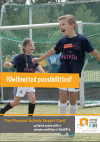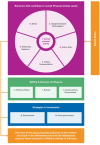2017 Dutch Report Card+: Results From the First Physical Activity Report Card Plus for Dutch Youth With a Chronic Disease or Disability
- PMID: 29761094
- PMCID: PMC5937055
- DOI: 10.3389/fped.2018.00122
2017 Dutch Report Card+: Results From the First Physical Activity Report Card Plus for Dutch Youth With a Chronic Disease or Disability
Abstract
Background: The Dutch Active Healthy Kids (AHK) Report Card+ (RC+) consolidates and translates research and assesses how the Netherlands is being responsible in providing physical activity (PA) opportunities for youth (< 18 years) with a chronic disease or disability. The aim of this article is to summarize the results of the Dutch RC+. Methods: Nine indicators were graded using the AHK Global Alliance RC development process, which includes a synthesis of best available research, surveillance, policy and practice findings, and expert consensus. Two additional indicators were included: weight status and sleep. Results: Grades assigned were: Overall Physical Activity, D; Organized Sports Participation, B-; Active Play, C-; Active Transportation, A-; Sedentary Behavior, C; Sleep C; For Weight Status, Family and Peers, School, Community and Built Environment, Government Strategies, and Investments all INC. Conclusions: The youth with disabilities spend a large part of the day sedentary, since only 26% of them met the PA norm for healthy physical activity. Potential avenues to improve overall physical activity are changing behaviors regarding sitting, screen time, and active play. The Netherlands is on track regarding PA opportunities for youth with disabilities, however they are currently not able to participate unlimited in sports and exercise.
Keywords: children; chronic disease; disability; exercise; health; youth.
Figures
References
LinkOut - more resources
Full Text Sources
Other Literature Sources
Miscellaneous




